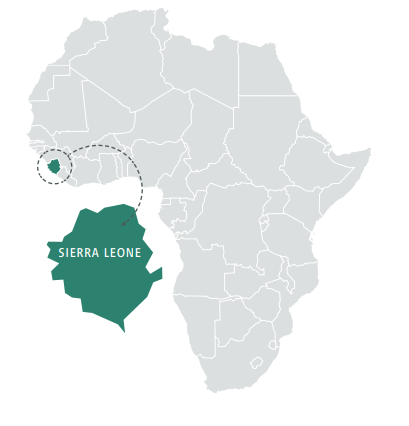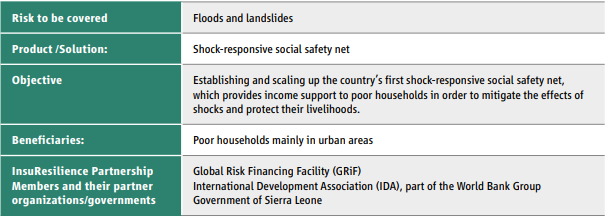Sierra Leone is highly exposed to landslides, droughts and floods. In 2017, the worst disasters in its history hit Sierra Leone causing massive destruction, food insecurity, economic losses and disaster-related health risks. Crisis-responsive mechanisms in place enable a quick response and therefore make the country and its people less dependent on humanitarian aid.
Sierra Leone is highly prone to natural disasters such as floods, droughts, and landslides which could be aggravated by climate change. A massive landslide occurred in the western rural area in August 2017, impacting about 6,000 people and causing total economic losses of about USD 31.65 million, or 0.8% of GDP in 2016, and increasing food insecurity of vulnerable households. Disaster-related health risks also remain a key concern in the country since 40% of Sierra Leone’s population live in urban areas comprising poorly constructed slums.
Investment project financing from the World Bank was allocated to support the establishment and scale up the country’s first shock-responsive social safety net so as to increase the financial resilience of extremely poor households in Sierra Leone to disasters and crises. This provides income support to poor households with the aim of mitigating the effects of shocks and protecting their livelihoods. This project will build, test and institutionalize systems to create a crisis-responsive mechanism for the poorest and most vulnerable regions in Sierra Leone. For the first time, the proposed approach gives the government full ownership, empowering them to fulfil their role through investing in systems and capacities to manage crisis response. This is important for reducing Sierra Leone’s reliance on unpredictable and uncertain humanitarian aid and institutionalizing a shock-responsive safety net that protects the country’s poorest population segments against shocks.


The safety net will prioritize landslides and floods to trigger emergency transfers, and it will also be designed to provide emergency transfers in response to health emergencies given the prevalence of pandemic outbreaks.
Combined funding totalling USD 6.5 million was granted by the GRiF and the International Development Association (IDA), the part of the World Bank Group that helps the poorest countries. Together, these funds will support cash transfers and system building activities for operationalizing the scale-up of the social safety net, as well as technical assistance that will strengthen preparedness and support the development of further risk-transfer solutions.
Supporting implementation of the InsuResilience Vision 2025, the project has been designed to promote government ownership by ensuring that contingent financing is directly integrated in the government budgeting process, through a budget line dedicated to financing emergency response as part of a government driven system. Furthermore, the technical support from the World Bank aims to build a monitoring and evaluation component that informs future design of prearranged financial solutions, as well as improving local capacity in crisis and disaster risk financing, which will help diversify financial sources available to the country and build a nationally driven disaster response system that is instrumental for fighting poverty and promoting sustainable growth in the long term.
BY SUMATI RAJPUT AND RUI XU (GFDRR, THE WORLD BANK)
